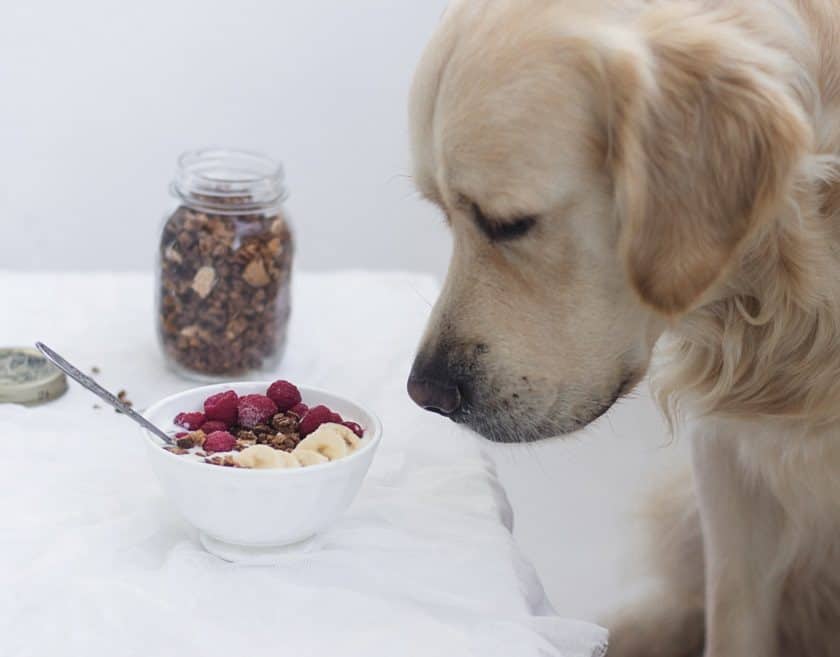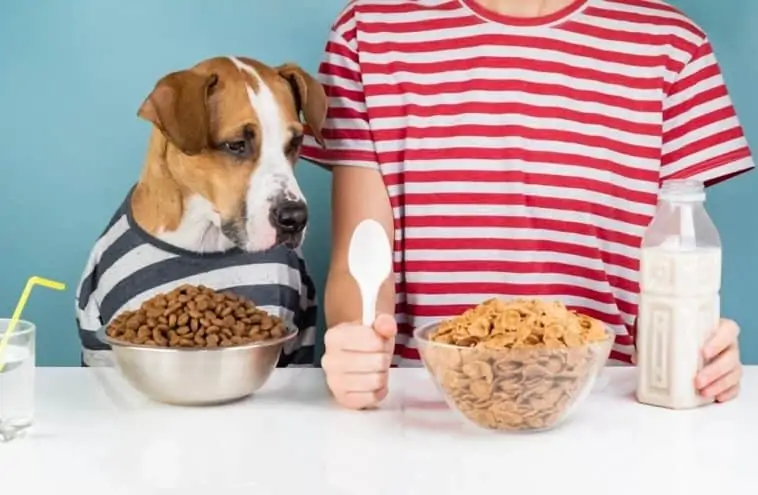The main ingredients in granola tend to be rolled oats and puffed brown rice, both of which are safe for dogs to consume. The issue arises as many granola brands contain high levels of sugar, which can be detrimental to your dog’s health.
Table of Contents
How often can you feed your dog granola?
Granola, provided it does not contain ingredients that are toxic to your dog, can be fed as an occasional treat. The sugar content is relatively high in most shop-bought granolas and so you should be cautious not to feed your dog too much.
That being said, there are many other foods available that will be much safer and more beneficial for your dog to eat. Granola is not a good choice of dog snack, but in a pinch, it is fine to give them a small amount.
What are the health benefits of granola?
Most granolas will contain a decent amount of fiber and slow-release carbohydrates from oats and brown rice. Fiber is useful to ensure the digestive system of your dog works correctly and it can prevent them from becoming constipated.
Slow-release carbohydrates are good for your dog as the energy and sugars are released into the bloodstream slowly. This prevents spikes and dips in their blood sugar levels and keeps them at a more stable level.
Granola will also supply your dog with some other base nutrients such as iron, potassium, calcium, vitamin A, and vitamin C. There is also a moderate amount of protein and cholesterol in granola. These are all vital to their health and the optimal function of their bodies.
That being said, there are many other foods appropriate for feeding your dog that will hit all of these criteria in a much healthier and more balanced way.
Are there any dangers to feeding your dog granola?
Granola contains a lot of fiber. Fiber is great for your dog in moderation, but excessive quantities can cause them to suffer bouts of diarrhea and stomach cramps.
As we have mentioned, the sugar levels in granola can be an issue for dogs. You should keep an eye out for anhydrous dextrose, corn syrup (and corn syrup solids), dextrose, fructose, HFCS (high fructose corn syrup), lactose, malt syrup, honey, maltose, molasses, maple syrup, sucrose, and nectars in the ingredients list.
These are all refined sugars that can potentially cause harm to your dog. Too much sugar can lead to obesity, diabetes, oral infections and tooth rot, and other metabolic issues.
If the granola is labeled sugar-free you may assume it is safe to feed to them, but this is rarely the case. This is often replaced with a chemical sweetener such as xylitol. This is very toxic to dogs and they should not be allowed to consume it.
There are often high levels of fat found in granola too, commonly from canola oil. This is refined fat and will not sit well with your dog’s digestive system. You will also find a lot of nuts in granola. While it is only really macadamia nuts that you can never feed to dogs, the elevated fat levels will do them no favors.
The texture of granola makes it a fairly serious choking hazard, especially when coupled with the speed at which most dogs eat their food.
As well as this, a buildup of nuts and seeds in the intestines and bowels of your dog can create an obstruction. If you suspect this is the case then you must take your dog to a veterinarian immediately.
How should you feed your dog granola?

The best and safest way to feed your dog granola is to make a dog-friendly version yourself at home. This ensures that there are no harmful ingredients in it and you can feel confident that they will not become unwell after eating it.
Dog-friendly granola bites
Ingredients
- 2 cups uncooked rolled oats
- ¼ cup pepitas
- ¼ cup sunflower seeds
- 1 tablespoon flax seeds
- ¼ cup shredded coconut
- 2 tablespoons chopped dried fruit (NOT RAISINS)
- 1 tablespoon coconut oil
- 1 tablespoon honey
- 1 egg
- 1 ¼ cups unsalted and unsweetened peanut butter
- ¾ cup almond milk
- 1 teaspoon ground turmeric
Method
- Preheat your oven to 325 degrees Fahrenheit. Line a baking sheet with parchment paper in preparation.
- Place all of the seeds into a food processor and blend slightly until they are coarse.
- In a separate bowl, combine all of the dry ingredients.
- Place the coconut oil and honey in a saucepan and heat over medium heat until the oil has melted.
- In a small bowl, beat your egg.
- Add the peanut butter to a food processor along with the almond milk and blend.
- Once blended add in the egg and your oil-honey mixture and blend again.
- Pour your liquid mixture into the bowl of your dry ingredients. Mix well, it should begin to stick together and hold its shape. If it is too wet, you can add in a little whole wheat flour to bind.
- Spoon out small balls of the mixture and shape them into balls using your hands. The balls should be approximately 1 ½ inch in diameter.
- Place the balls fairly close together on your prepared baking sheet. They will not spread out as they bake.
- Transfer the baking sheet to the oven and bake for around 30 to 40 minutes, until they have turned a delicious golden brown. If you like, flip the balls halfway through the cooking time for a more even bake.

